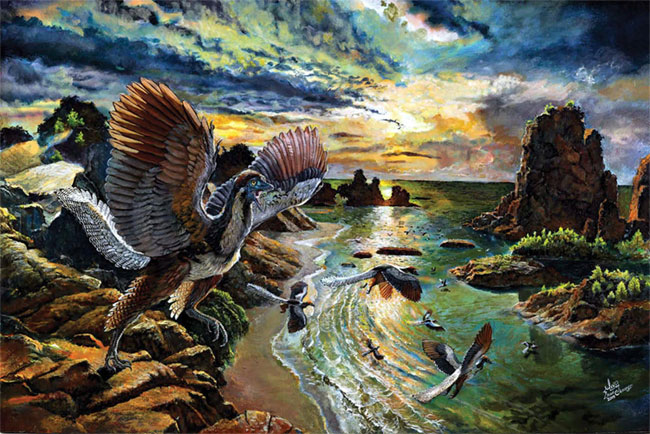Decoding fossil birds discovered the unknown species on Earth
A "ghost" fossil of one of the world's first bird species has been identified by scientists as a previously unknown species in the famous Archeopteryx.
The researchers said, is a transition fossil in the development of dinosaurs for birds. It brought a surprise because it was only the size of a crow but it could fly throughout its life.
Martin Kundrát, classical researcher at Pavol Jozef Šafárik, University of the Slovak Republic, said: "Like other birds, this Archeopteryx species has claws and sharp teeth that can capture and cut prey. , like lizards, insects, snails and worms ".
"I will describe it as a toothed chicken and a long tail," Kundrile said. Scientists named the new species Archeopteryx albersdoerferi.
Archeopteryx was first discovered in Bavaria, southern Germany in 1861. Since then, scientists have studied 12 skeletons of 150 million-year-old organisms.

Illustration of Archeopteryx albersdoerferi about 150 million years ago.(Photo: Livescience).
"In addition to the previous models, some new samples were also analyzed. Archeopteryx appeared about 400,000 years older than the other" first birds "known and it became the oldest archeopteryx recorded. albersdoerferi is also the second small Archeopteryx specimen to be recorded, based on the length of ulna of the creature (wing) , Kundra analysis.
Fossils (one of the 12 skeletons found so far) were discovered in 1990 in Mörnsheim Formation of Bavaria. Kundrile said: "It changed many times before being sold to a private collector in the belief that it was a flying lizard. The scientific community did not know about this specimen until 1996. , when a specimen is taken at the Naturkundemuseum - a Natural History Museum in Bamberg, Germany ".
"The original model became famous but was rarely seen so it was nicknamed" ghost. "Finally, in 2009, Albersdörfer bought fossils from a private collector and included it in the Collection. Albersdörfer also signed a contract saying that he would not sell specimens to a non-public organization, ensuring that fossils would be for science, " Kundrati said.
To study the specimen, the scientists used synchrotron microscopy, a state-of-the-art X-ray imaging technique. This allows them to virtually reproduce and dissect A. albersdoerferi fossils as well as identify animal bone adaptations that can help it fly.
The virtual test also revealed that A. albersdoerferi has the ability to develop flight-related features, but needs more testing to be sure.
"This study is a good step in the study of Archeopteryx," said Steve Brusatte, a paleontologist at the University of Edinburgh in the UK, who did not participate in the study.
"The most important thing about this new fossil is that it has been studied in detail by synchrotron tomography. With this method provides unprecedented details about the small features of surgery that are too difficult to see with the naked eye." , Brusatte said. "It is clear that this new specimen has a lot of anatomical features that show that flying animals, such as shoulders and wings, have high blood vessels and fused and reinforced hands."
Although scientists have debated Archeopteryx's ability to fly for years, "when I look at this new fossil, I see the highlight of an animal that can flap its wings and keep it in the air". , Brusatte said.
- For the first time, an ancient bird fossil was discovered in the Middle Ages
- Discovered a new species of platypus
- The turtle fossil has never been known
- Peru discovered strange ink fossils with 85 million years
- Found fossils of ancient birds after dinosaurs extinction
- The most intact bird fossil in amber 99 million years
- Bird fossils 90 million years help predict the future of the Earth
- Detecting fossil fossils strange 99 million years in amber
- New fossil fossil families discovered
- Traces of ancient reptiles have never been discovered
- Ancestors of birds - Archeopteryx
- Displaying the oldest fossil samples in history in Brazil
 Discovered an ancient centipede fossil 99 million years old
Discovered an ancient centipede fossil 99 million years old Discovered bat-like dinosaurs in China
Discovered bat-like dinosaurs in China Discovered a 200-year-old bronze cannon of the coast
Discovered a 200-year-old bronze cannon of the coast Discover 305 million-year-old spider fossils
Discover 305 million-year-old spider fossils Archeopteryx dinosaurs fly like pheasants
Archeopteryx dinosaurs fly like pheasants  Waterbirds are dinosaurs?
Waterbirds are dinosaurs?  Discovering Archeopteryx - discovering surprising signs of dinosaurs
Discovering Archeopteryx - discovering surprising signs of dinosaurs  Ancient birds fly with 4 wings
Ancient birds fly with 4 wings 